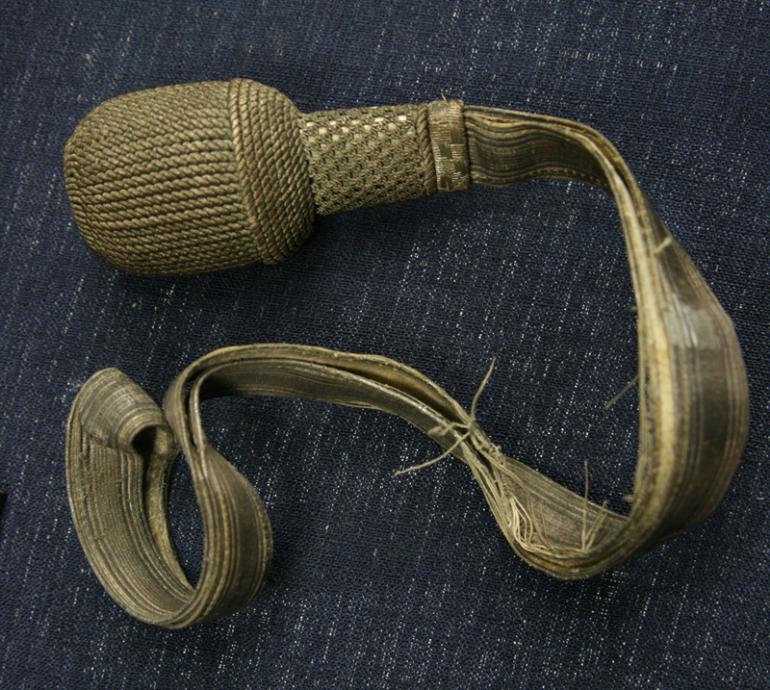GERMAN PRUSSIAN PRESENTATION IOD1889 IN DAMASCUS - SUPERB!
$0.00
Out of stock
This unique Infanterie Offizier Degen Modele 1889 is dedicated on the blade TO THE MOST RESPECTED COMMANDER HERR OBERST VON ALVENSLEBEN FROM OFFICERS OF THE GRENADIER REGIMENT OF KARL, PRINCE OF PRUSSIA [2ND BRANDENBURG] NR.12 and dates 1890-1894. Blade is richly decorated in gold-washed etching, and is of fine damscus.
Colonel, later general Ludolf von Alvensleben was a career Prussian infantry officer, whose father was a general, and his father before him, et al. Ancient Prussian nobility family name von Alvensleben dates back to the Knights of the Middle Ages, and perhaps to the Crusades.
General's son, also Ludolf von Alvensleben is better known than his father.
From Wikipedia - Ludolf-Hermann Emmanuel Georg Kurt Werner von Alvensleben (March 17, 1901 – March 17, 1970) was a Nazi official with the rank of SS-Gruppenführer and Major General of the police (1943).
Alvensleben was born in Halle to the lower German noble family von Alvensleben. His father was a Prussian Major General Ludolf von Alvensleben (1844-1912), his mother, Antoinette von Alvensleben (1870-1950), née Freiin von Ricou. From 1911 to 1918 he belonged to the Prussian cadet corps. Then, in 1918 he joined the Husaren regiment, during World War I. Between 1923 and July 1929, he belonged to the Stahlhelm, Bund der Frontsoldaten. After the war, Alvensleben graduated with a degree in Agriculture. After the death of his father in December 1912, the family's Schochwitz manor, which had been inherited from Alvensleben's grandfather, the Prussian general Hermann von Alvensleben (1809-1887), became his own. He wed on May 3, 1924; the marriage produced four children.
Alvensleben became a member of the Reichstag in 1933; on April 5, 1934, he became commander of the 46th SS-standard in Dresden. Later on, Alvensleben was made first adjutant of the Reichsführer SS, as well as chief of the German police; his career continued with appointments to commander of the SS and police in Crimea and commander of the Selbstschutz of Reichsgau Danzig-West Prussia. During his command mass executions and atrocities took place, with over 4,000 Poles murdered by early October, and German officials reporting up to 20,000 Poles "destroyed" in the end.
In April 1945, Alvensleben was captured and held in British captivity. At the end of 1945, he made an escape from the internment camp at Neuengamme. After a short stay in Schochwitz, he fled with his family to Argentina in early 1946. Although there is no precise data on the date of their arrival in the country, a 2000 documentary film record that on November 27, 1952 the government of Juan Domingo Perón granted Alvensleben citizenship under the name of Carlos Lücke. He lived until July 1956 in Buenos Aires, then he moved to Santa Rosa de Calamuchita. Residents of Santa Rosa de Calamuchita as well remember with affection and admiration. In November 1952, he served as inspector of fish farming on Herrero-See as an Argentine citizen. Attempts by the prosecution had no consequences for Alvensleben. In January 1964, the district court of Munich put out an arrest warrant for Alvensleben for the killing of at least 4,247 Polish by units of the ethnic German Selbstschutz under Alvensleben's command in the autumn of 1939. Alvensleben died in 1970 without having been brought to trial.
The man escaped, but his father's sword was picked up by an American GI, and never saw the light of day, until I purchased it. Blade is 79 cm long and 2.6 cm wide. Sword was retailed by M.NEUMANN, HOFLIEFERANT BERLIN and bears the blade made by the most talented family of all the German bladesmiths - VOOS. A fabulous sword!












































































